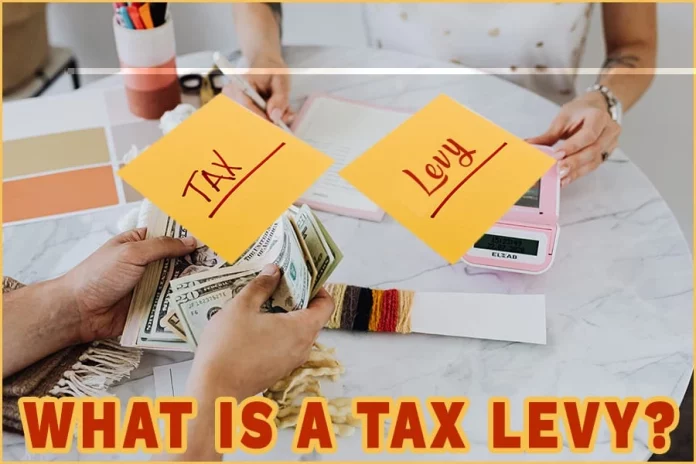In case you owe taxes to the government, the Internal Revenue Service (IRS) may pursue the collection of those taxes.
One of the ways the IRS may do this is by issuing a tax levy. Tax levies are a severe issue that no one ever wants to face. Unfortunately, sometimes they are unavoidable.
This article aims to educate you on what a tax levy is, the IRS’s steps to levy taxes, and your options if you find yourself in this unfortunate situation. Here’s everything you need to know about tax levies.
What Is A Tax Levy?
Tax levies occur when the IRS takes legal action to seize a taxpayer’s assets to satisfy an outstanding tax debt. You can expect the Internal Revenue Service (IRS) to seize your wages, bank accounts, and other assets to satisfy your delinquent tax bill.
The agency may also seize property, such as a home or car, to sell and use the proceeds to pay the tax debt. The levy will also attach to any future property or income until the debt is paid.
It’s one of the most severe collections actions the IRS can take against taxpayers, but one that the IRS may take if you don’t take action to address your tax debt.
How Does A Tax Levy Work?
When the IRS decides that a taxpayer owes more money than they can pay, they will issue a tax levy; this is the official notice that demands payment of the tax debt.
The levy will give the IRS the legal right to seize and sell any taxpayer assets, including property, bank accounts, and wages.
If you owe taxes, the IRS is obligated to inform you via letter, and you’ll receive it via mail. Keep your postal address current, and if you’re having financial difficulties, contact the IRS.
- A document known as a Final Notice of Intent to Levy will be sent to you via mail by the IRS. The notice gives the taxpayer 30 days to take action and pay the debt in full or make payment arrangements. If the debt is not paid, the IRS will take steps to levy the assets.
- They can either contact the bank and issue a bank levy or your employer for wage garnishment. And if that is not enough, they’ll issue a property levy and seize some of your assets to cover the sum owed.
What if you have other debt?
- The IRS has greater authority than other creditors since it is a government entity, so it can essentially move to the head of the queue. If you owe money to several creditors (such as the IRS, a mortgage lender, or a credit card company), the IRS is likely to collect first.
Examples Of A Tax Levy
The IRS can use several types of levies to collect taxes. The levy applies to all assets, including property, bank accounts, wages, and retirement accounts.
1. Bank levies
Bank levies occur when the IRS seizes money from a taxpayer’s bank account. The IRS usually sends a notice to the bank informing it of the levy.
The bank is then required to freeze the account for 21 days and send the sum of the money you owe to the IRS.
A tax levy can be on a single account or on all the accounts of the taxpayer/ business that owes the taxes.
2. Wage garnishment
The most common is the wage levy. The IRS can send a notice to an employer to withhold a certain amount of money from an employee’s paycheck each week/ month until the debt is paid.
3. Property seizure
A property seizure tax levy is the legal process by which a state or local government seizes and sells the property of a person or business to satisfy a tax debt. The IRS may seize any property that it believes will satisfy your tax debt.
The term usually refers to the seizure and sale of real estate but may include personal property, such as automobiles or boats.
4. Reduced tax refunds
The IRS may withhold funds that would otherwise be sent to you in the form of a tax refund. The IRS has the authority to charge state and municipal refunds and federal returns to force the state to deliver monies to the IRS rather than to you.
Is It Possible For A Tax Levy To Be Released?
Yes, it is possible to get the discharge of a tax levy. As a tax debtor, you have the right to file an appeal to stop a tax levy from going forward. You can even ask creditors to return levied assets to you after they’ve been taken.
To complete an appeal, make arrangements to pay your tax debt and request a tax levy release with the IRS as soon as possible.
You’ll deal with the IRS Independent Office of Appeals, not the IRS Collections office, when you file an appeal.
There are many reasons why IRS might release a tax levy;
- The most common reason is that the taxpayer has satisfied the debt that led to the placement of the levy; this could be through;
- payment in full
- an agreement to make installment payments
- or the acceptance of an offer in compromise from the IRS
2. The IRS also has the power to release a levy if it determines that the levy is causing undue hardship for the taxpayer.
Perhaps there are extreme financial issues, health issues, or other extenuating factors. However, you’ll still have to deal with your debt.
3. The IRS will also consider releasing a levy if it would be more advantageous to the government.
For example, if the levy prevents the taxpayer from selling assets that would generate more tax revenue than the amount owed, the IRS may release the levy.
How To Prevent a Tax Levy
Make Full And Timely Payment
It is imperative always to file your taxes in April and pay your tax bill in full and on time. If you don’t, the IRS can take action against you in the form of a tax levy. And if you can’t, there are other steps to take.
Pay Your Tax Bill Over Time
If you can’t settle your entire tax bill, try to pay at least the amount due for the current tax year. You can also pay your taxes in installments if you make all required payments.
Although you may still face interest and penalties, setting up an installment plan with the IRS prevents the IRS from presuming you just chose not to pay.
Make an Offer
Another way to prevent the IRS from seizing your assets is to make an “offer in compromise.” It’s a settlement that the IRS offers to taxpayers who cannot pay their entire tax liability.
The offer in compromise is a way for taxpayers to negotiate a reduced payment amount with the IRS.
The IRS will only accept an offer in compromise if they believe that the taxpayer can pay the whole amount of the tax liability, less than the amount offered.
To make an offer in compromise, you must provide detailed financial information to the IRS.
If you can’t afford to make an offer, you may need to consider bankruptcy as an option. Bankruptcy will stop the levy and provide you with some relief from your debts. However, it will also have long-term consequences that you must consider.
What Is A Tax Lien?
A tax lien is a legal interest that a creditor holds in your assets to ensure future payment. The IRS could use a tax lien as an alternative to the tax levy.
The lien is usually filed to secure future payment of the taxes owed through the sale of your assets.
For instance, the IRS might place a lien on your home to secure payment of taxes you owe. The IRS then proceeds to create a tax lien by filing documents at local government offices, making this information public.
Unlike the tax levy, a tax lien is a public record and can impact your credit report.
A tax lien could be problematic for you if you want to sell your house or use it as a guarantee to refinance another asset. Creditors won’t want an asset that has debt claims by the IRS, and they will not approve your loan.
Conclusion
This article has provided a comprehensive overview of tax levies and what you need to know to make sure you don’t get one– from understanding the concept to taking action and getting the levy lifted.
If you find out that you may owe taxes, it’s crucial to take action sooner rather than later to avoid a levy by setting up payment installments or making an offer in compromise to the IRS. We hope that you’ve found this article to be helpful and informative.












